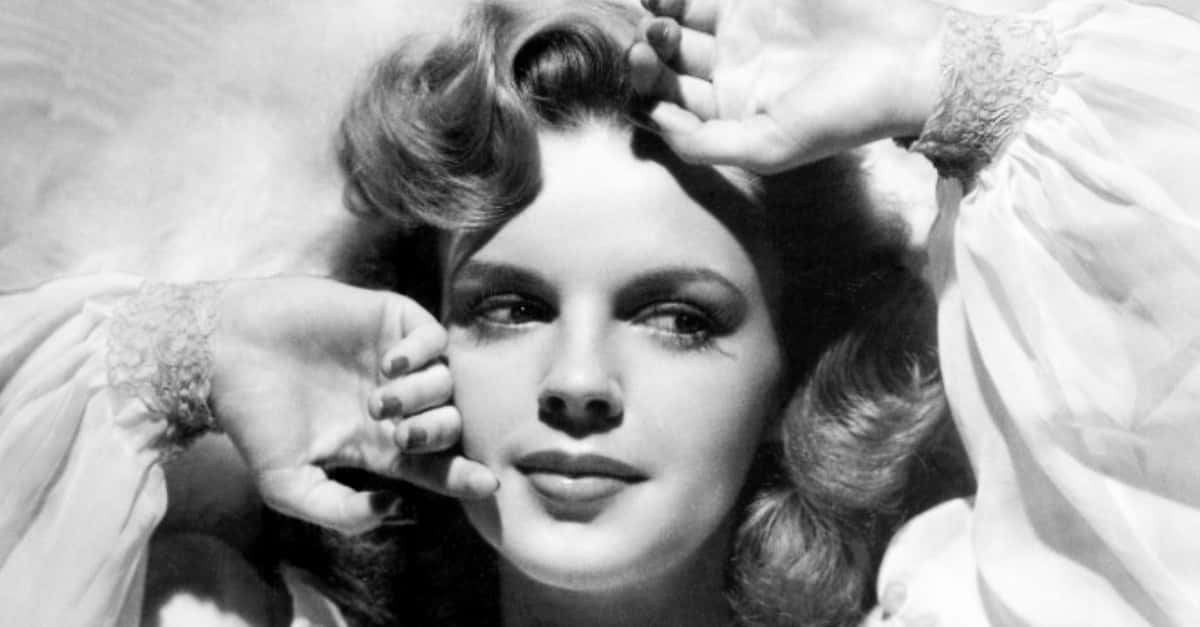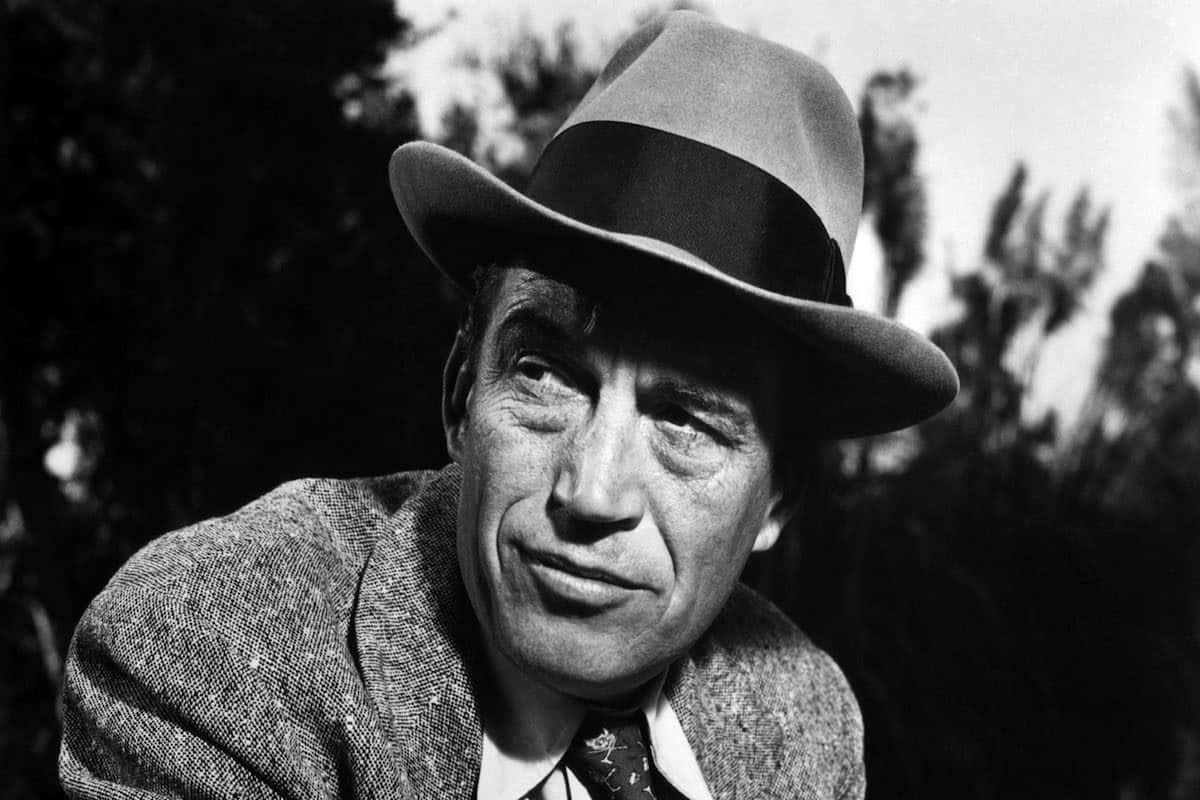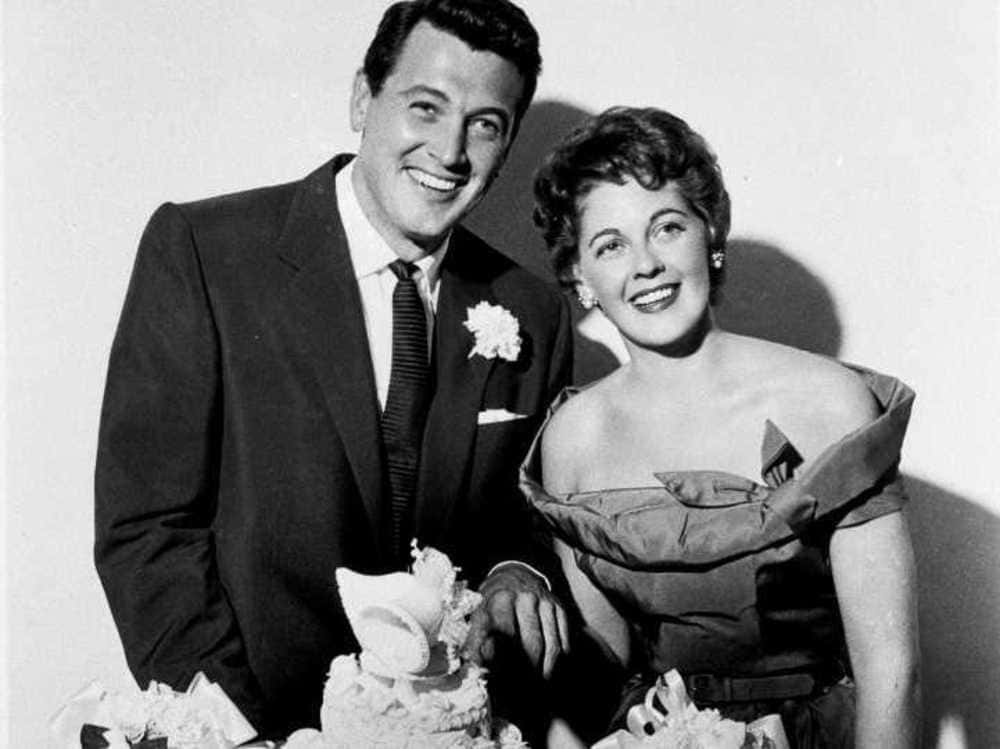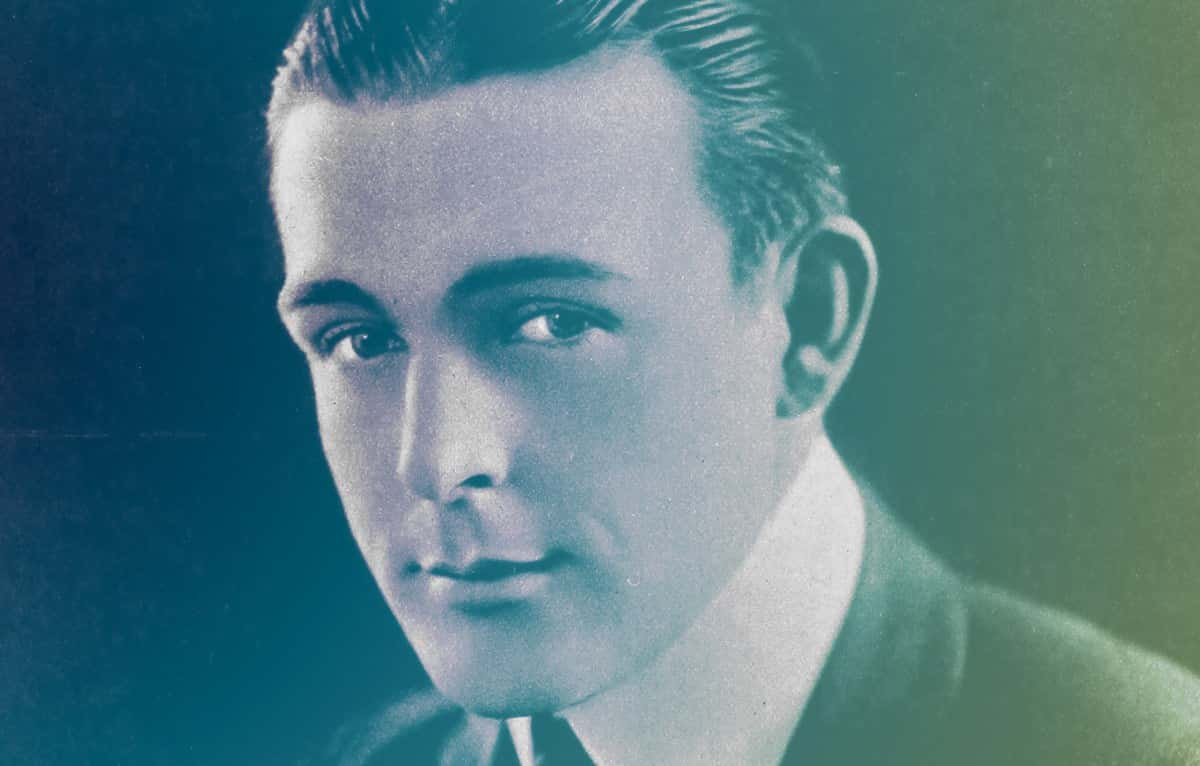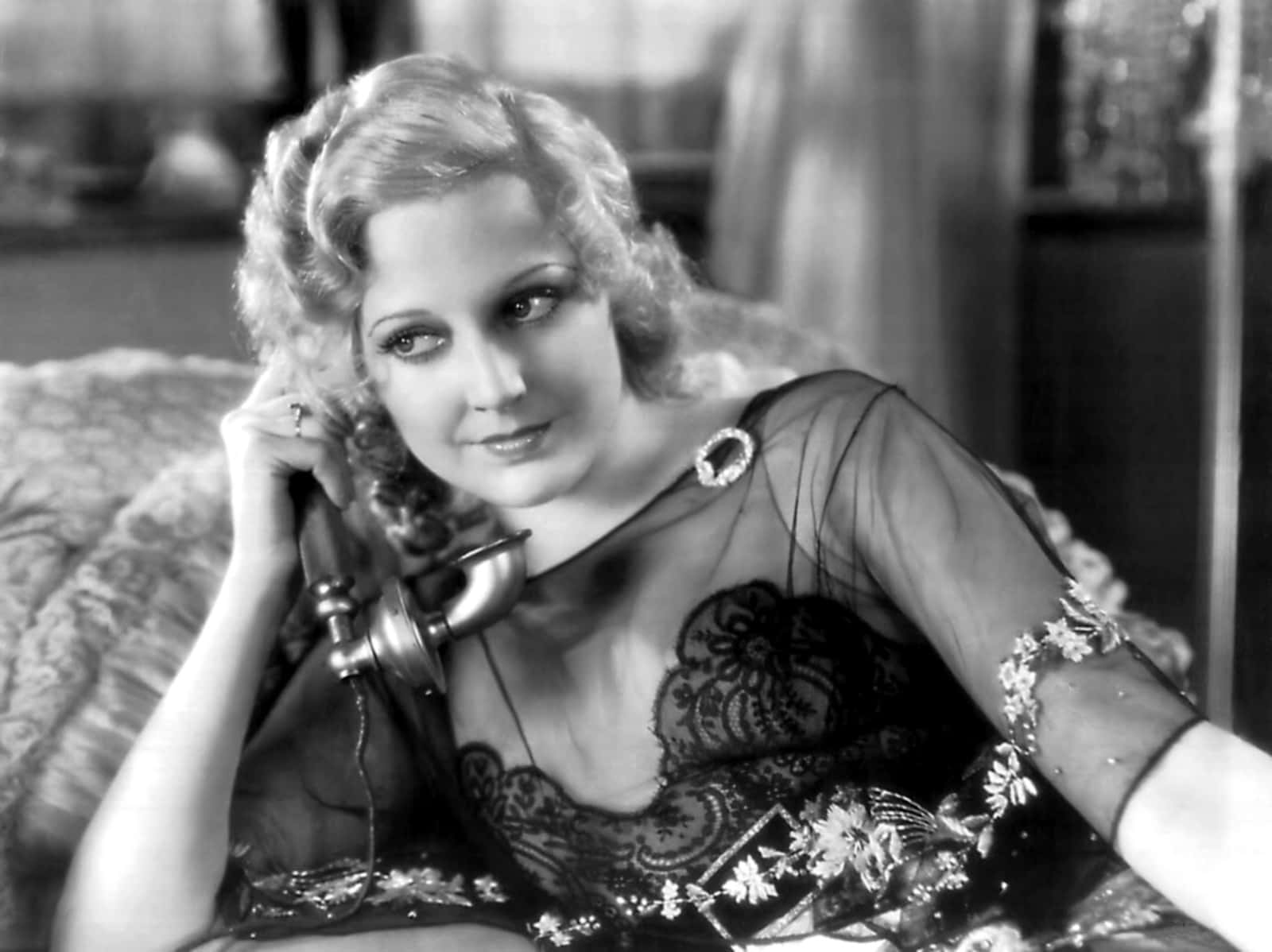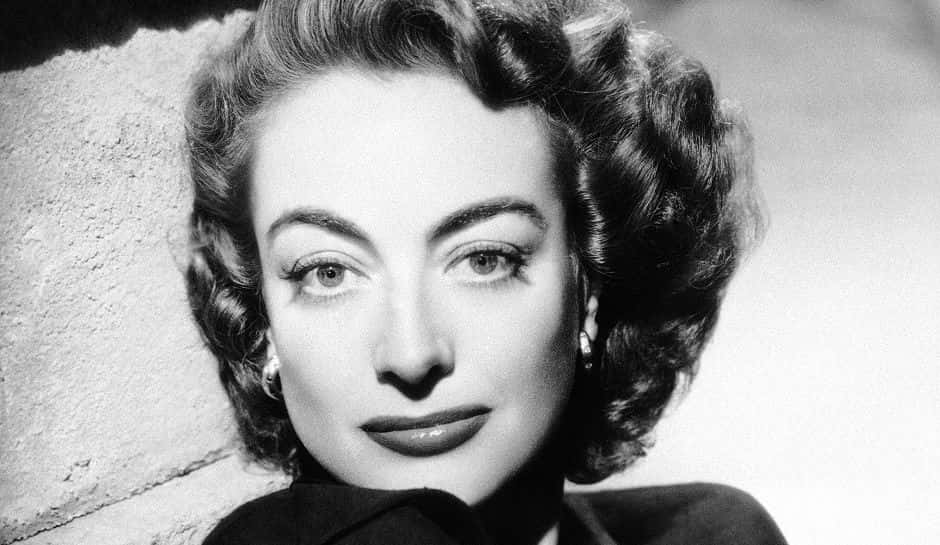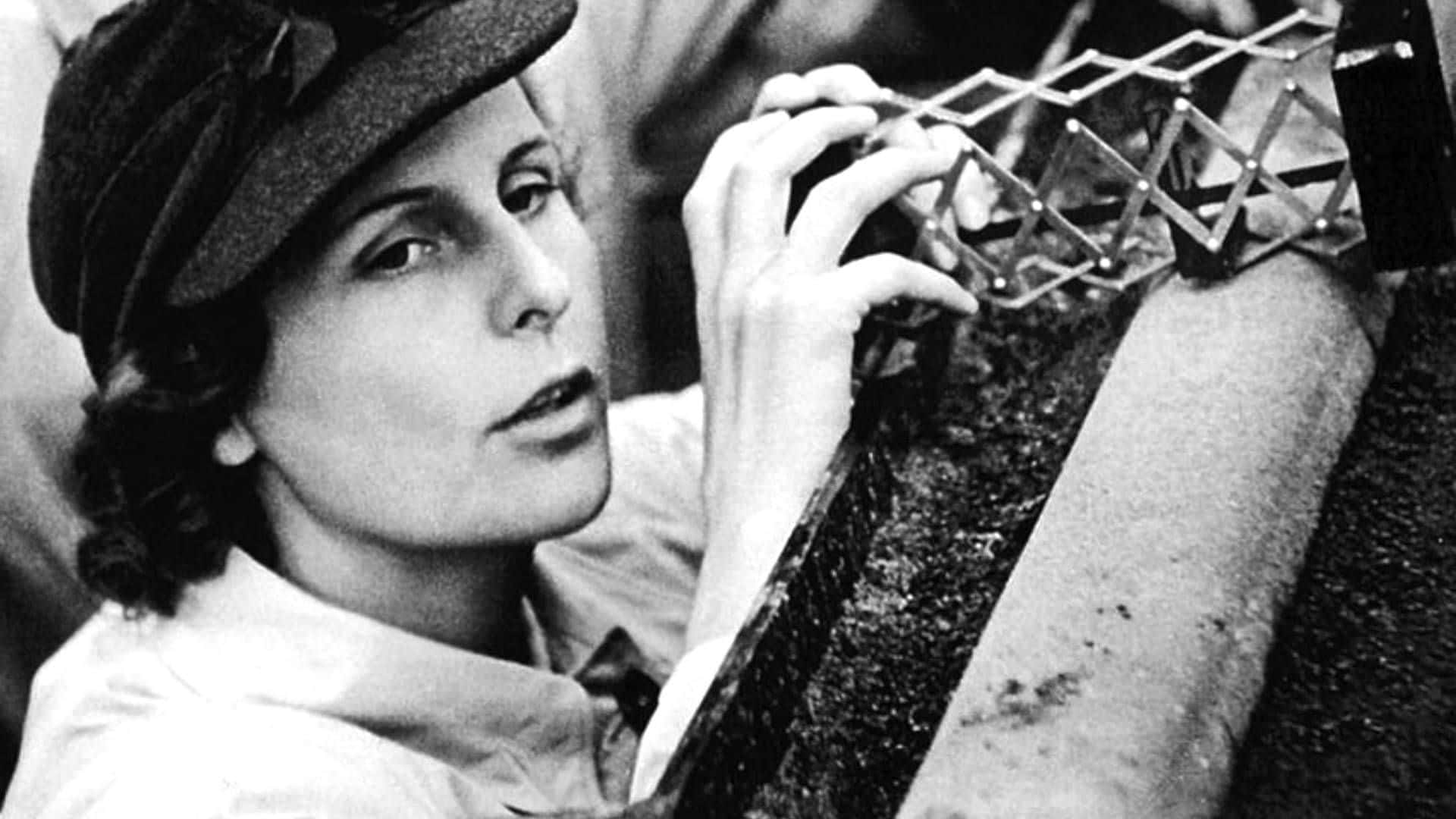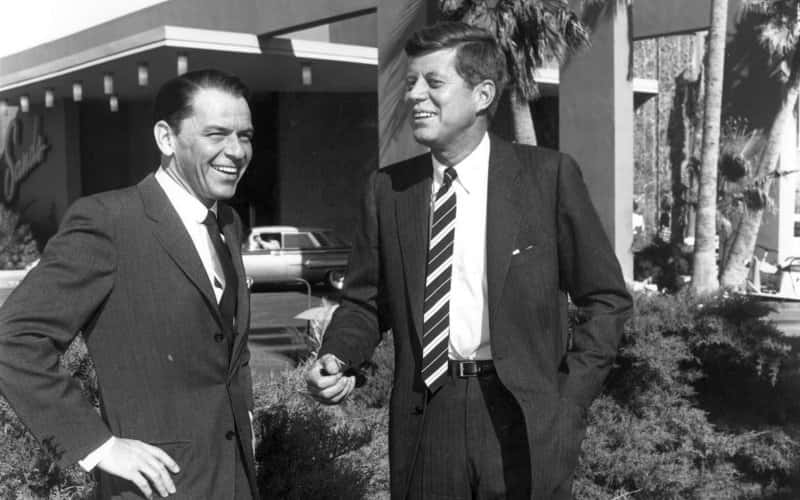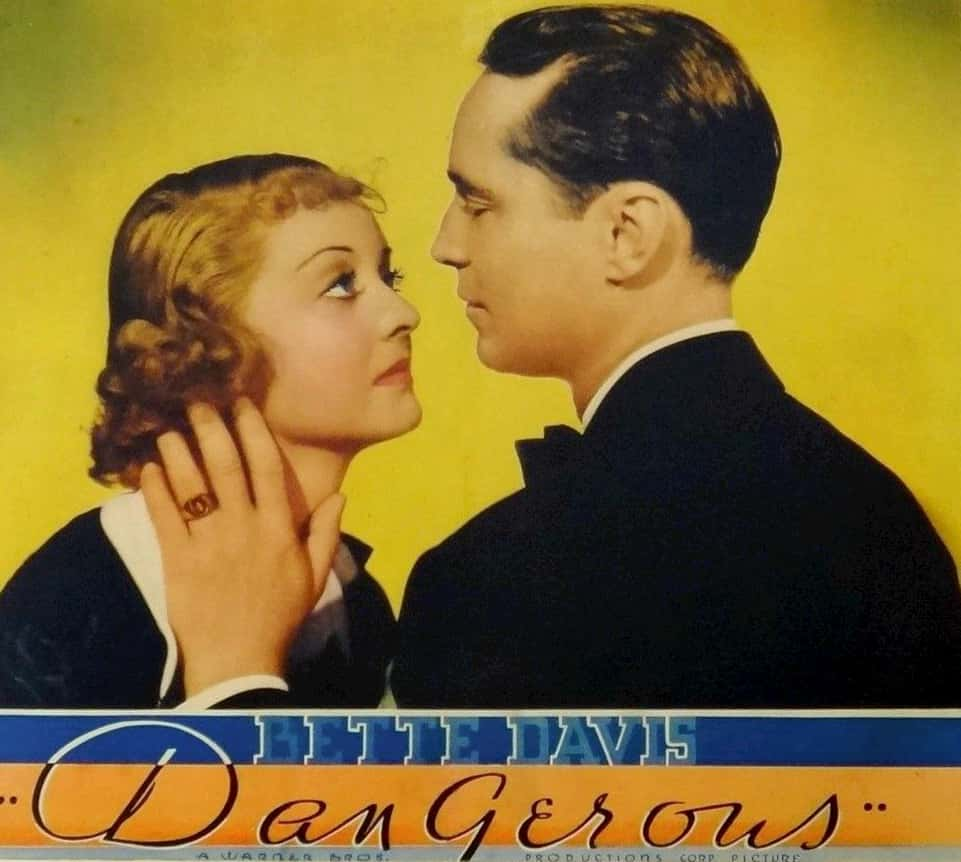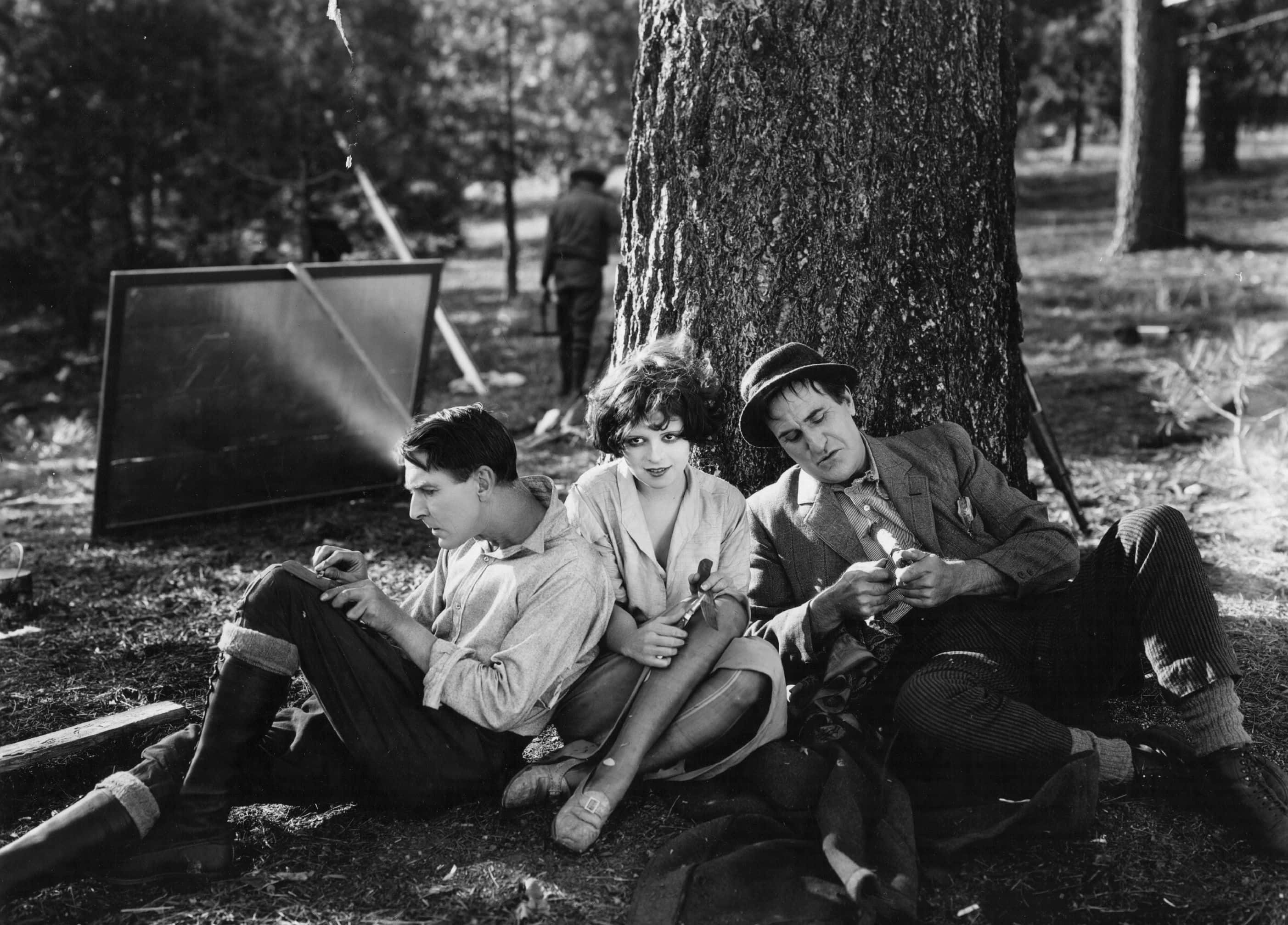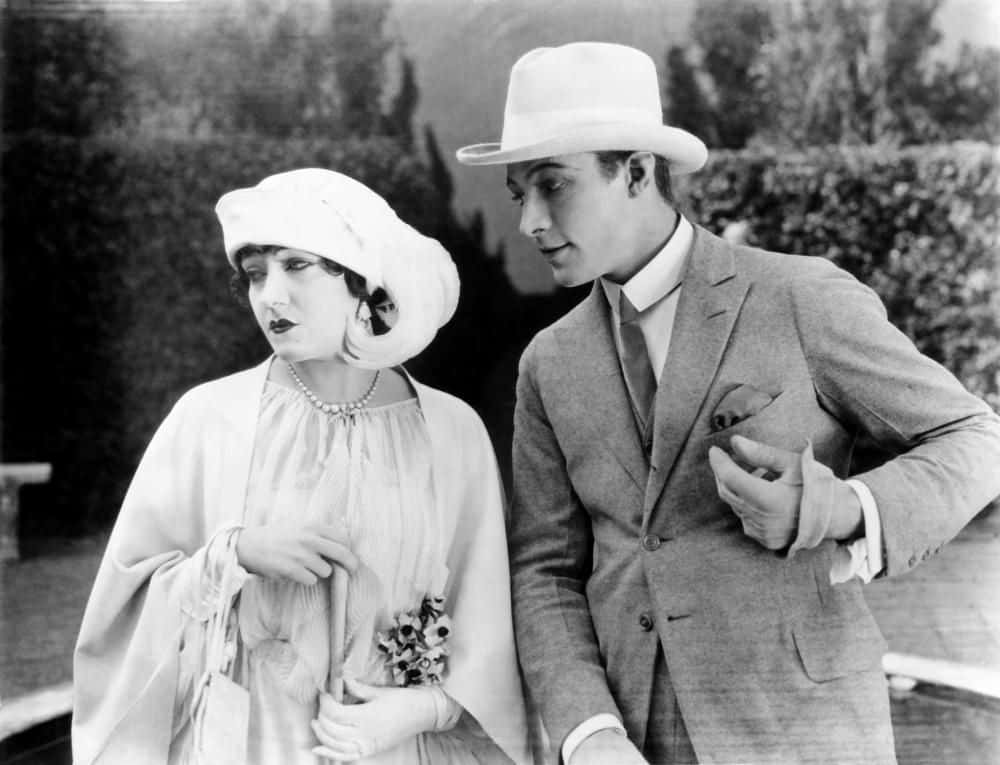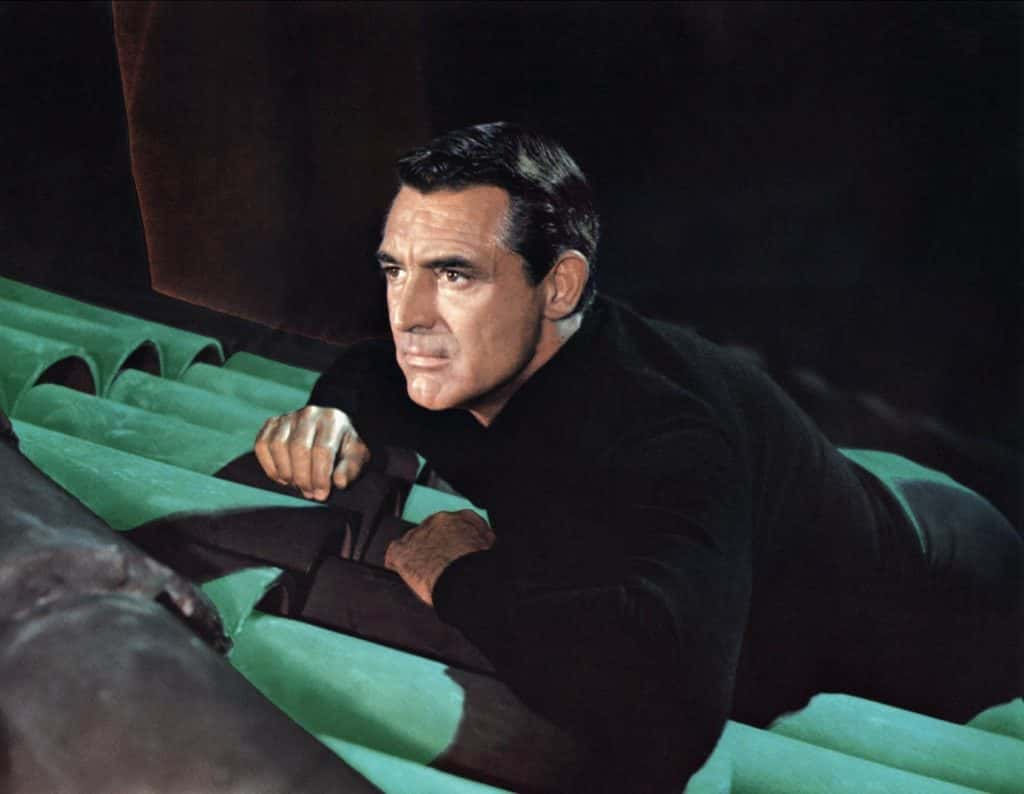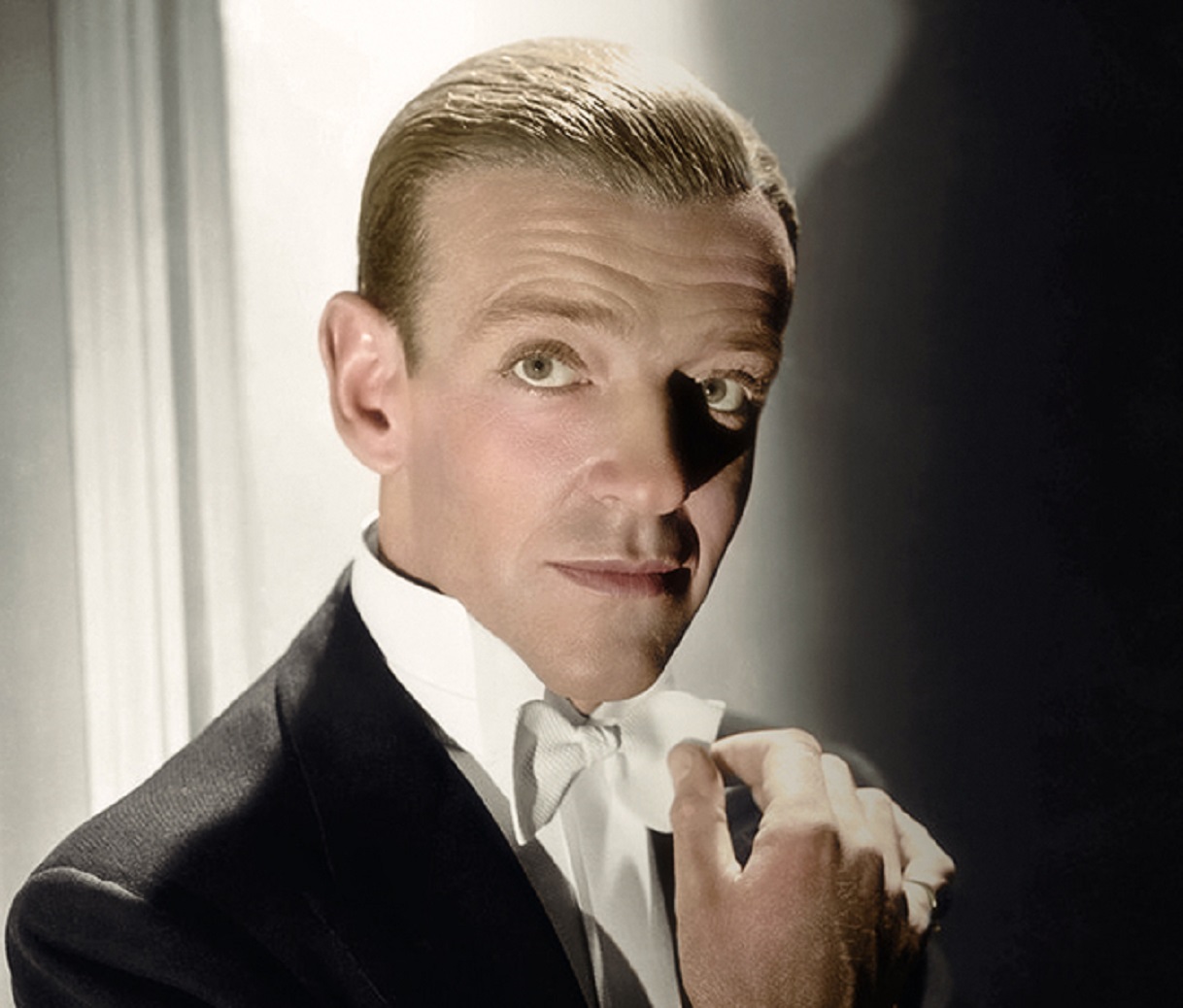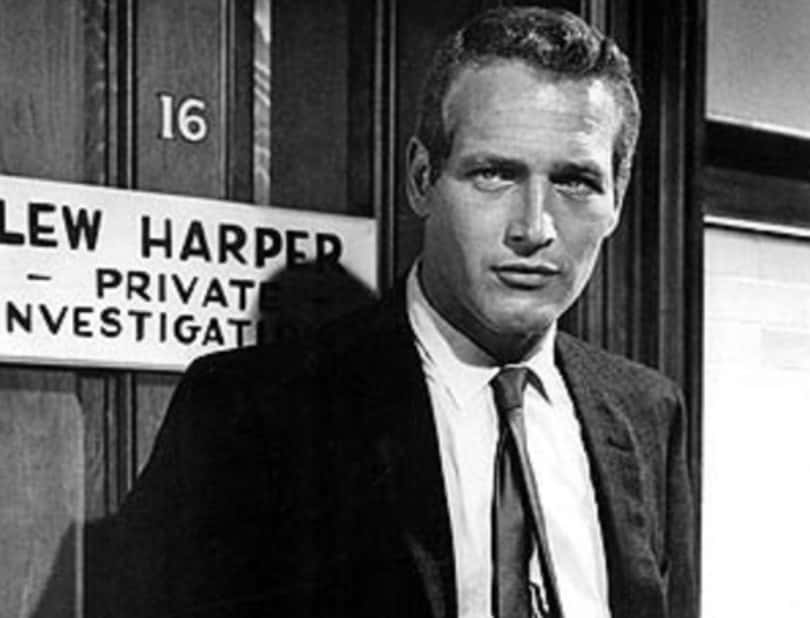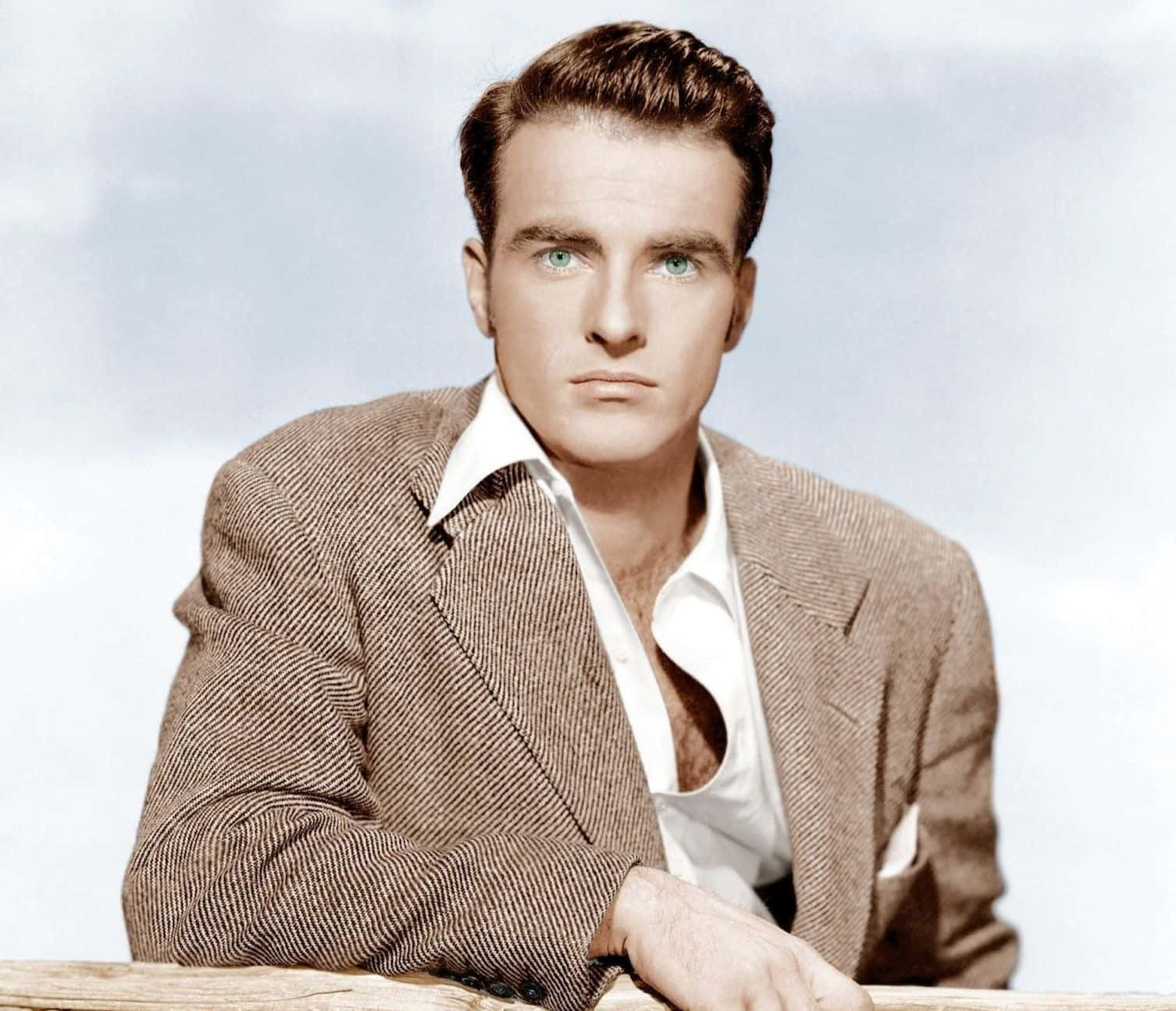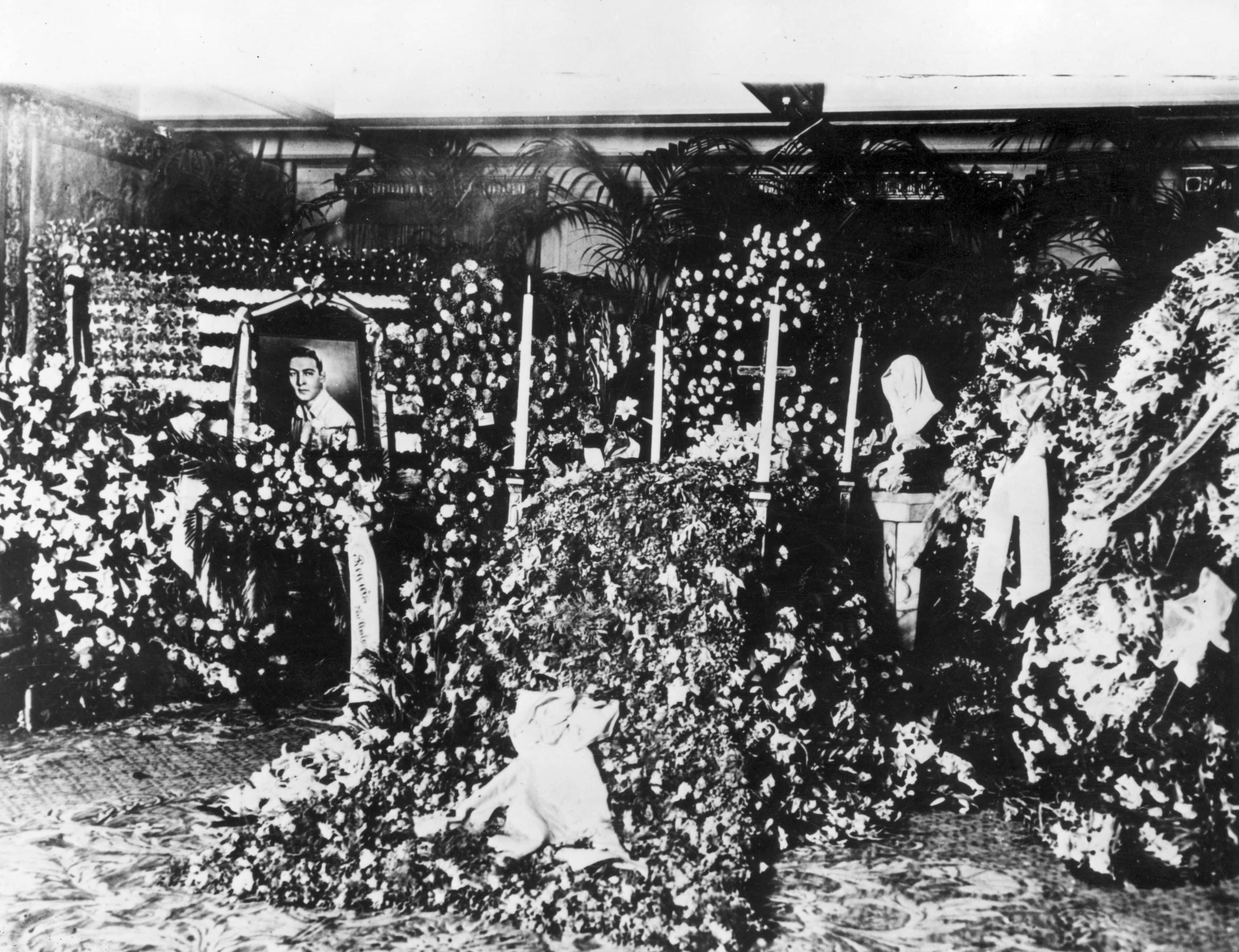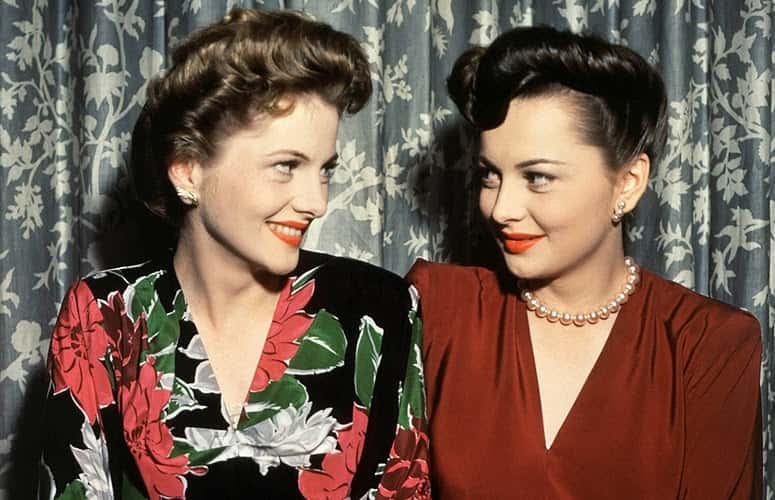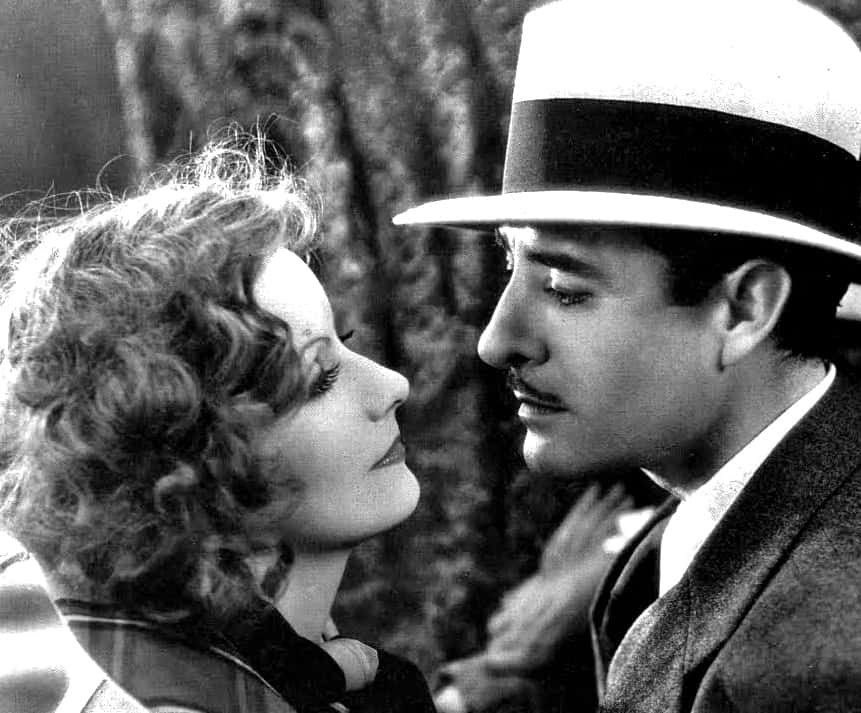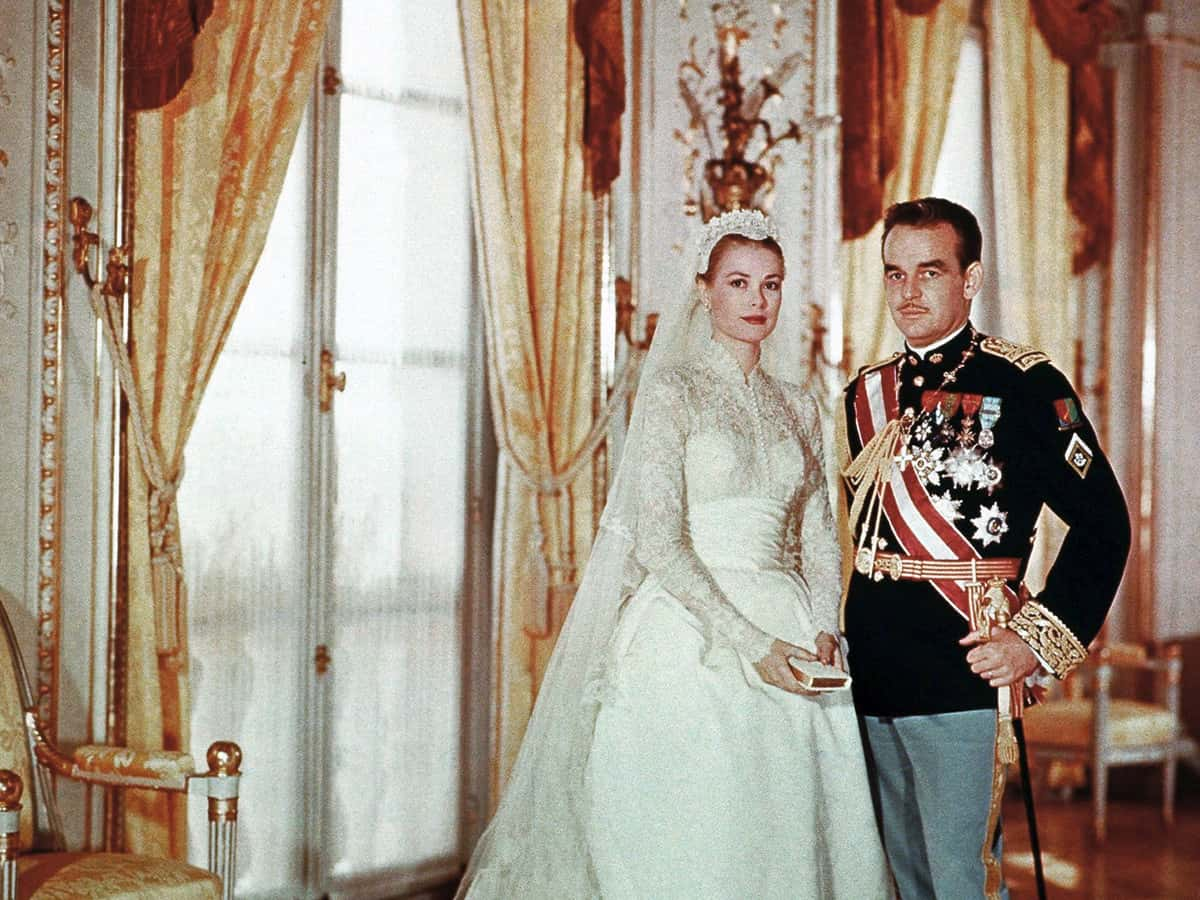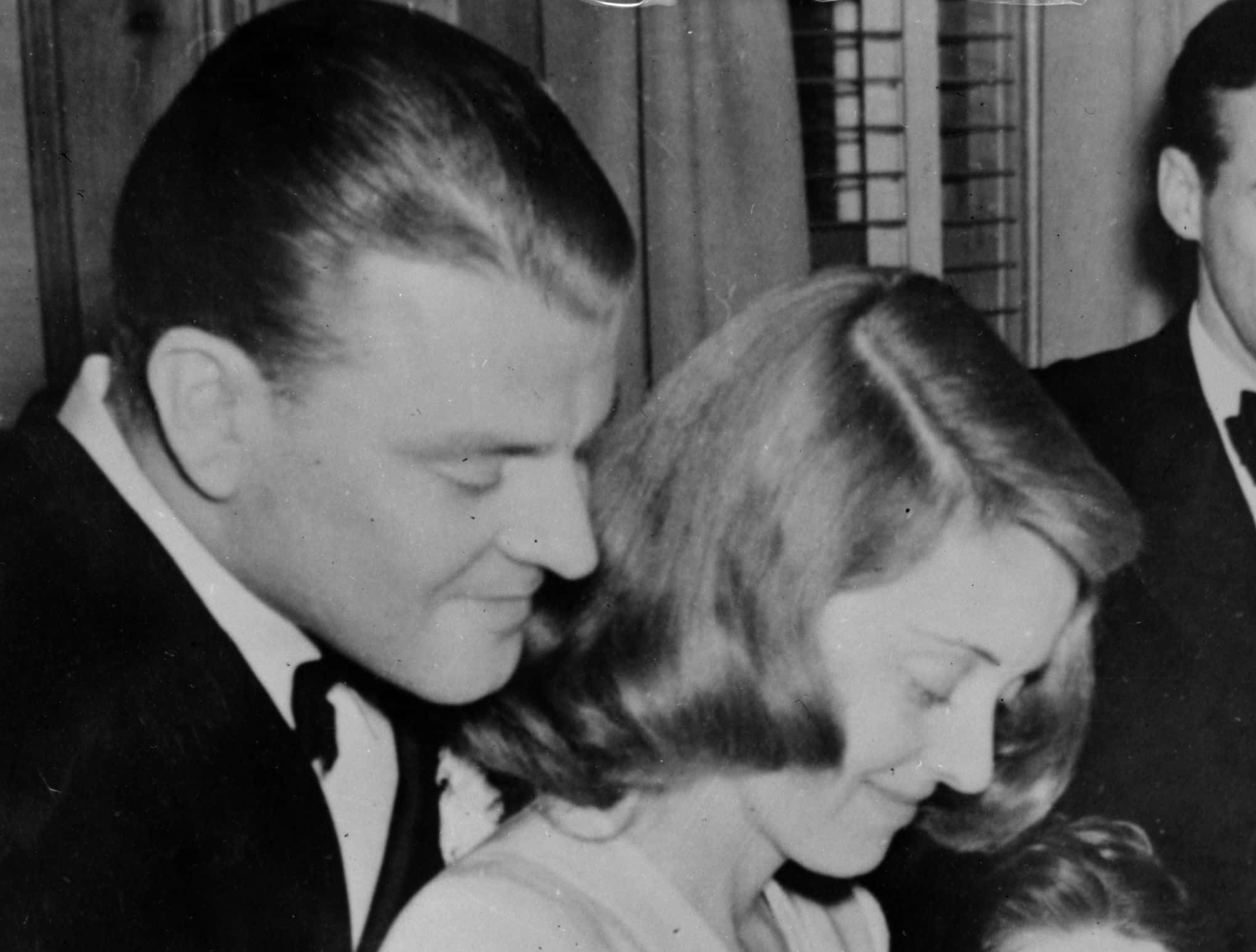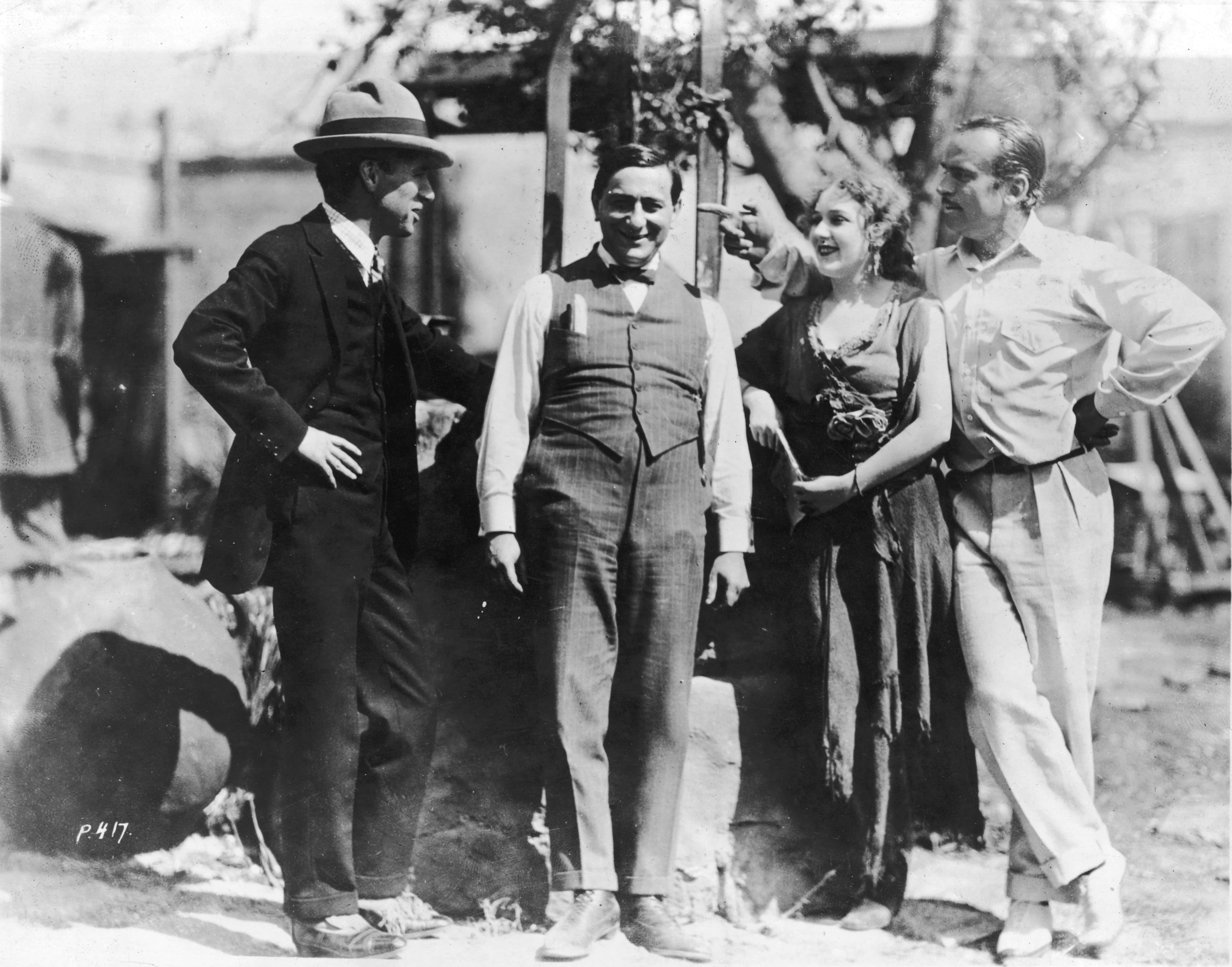Sometimes it seems like there's never been anything as glamorous as Old Hollywood. Well, for every diamond necklace, every Oscar statuette, every fur, and every fairy-tale romance, there have been equal parts scandal, melodrama, tragedy, and woe. From stars who pushed the limits of what was acceptable to those who burned brightly only to flame out young, Old Hollywood was chock-full of eye-opening tales of scandal.
1. Lived Fast, Perished Young
Aside from acting, James Dean also had a passion for cars and driving as fast as possible. One thing led to another, and on September 30, 1955, Dean was driving his Porsche 550 Spyder at high speed when he crashed into a car speeding in the opposite direction. He was 24 when he perished, having only performed in three films, two of which hadn't even hit theatres yet. He would receive two posthumous Oscar nominations, a record that nobody is likely to beat—we hope.

2. The Force Cannot Save This One
In one of the most infamous moments of foreshadowing in the history of American pop culture, James Dean met with renowned British actor Alec Guinness (aka the original Obi-Wan Kenobi) and took the moment to show off his new car. Guinness allegedly warned Dean that “If you get in that car, you will be found gone in it by this time next week". Guinness’ prediction proved horrifyingly accurate when Dean perished seven days later. It seems that Guinness was a Jedi before George Lucas had ever invented them.
3. What a Tramp
While he was busy capturing the hearts of the world with a prolific string of classic pictures, Charlie Chaplin was also a notorious womanizer. He claimed to have slept with over 2,000 women, and when he was asked what his ideal woman was like, he quipped, “I am not exactly in love with her, but she is entirely in love with me". Pretty gross there, Chap.
4. Hook ‘Em While They’re Young
One thing that Charlie Chaplin’s pursuits had in common was their youth. He first met and engaged in a romance with Edna Purviance when she was 19. He later moved on to Mildred Harris, who was 16 when the 29-year-old first met her. He impregnated the teenaged Lita Grey (whom Chaplin had first become interested in when he’d met her as a 12-year-old).
Incidents like these continued until the 54-year old Chaplin married the 18-year old Oona O’Neill, with whom he finally did have a decent marriage, as well as eight children. So that’s a happy ending for...Chaplin, at least.
5. The Look
Lauren Bacall’s trademark facial gesture, known as “The Look,” was actually borne out of nerves on the set of her first film, To Have and Have Not. She kept her chin pressed against her chest to keep from shaking until just before the cameras rolled, which is why she began every shot by bringing her gaze upward.
6. He Was Nothing but a Hound Dog
Despite being the King of Rock & Roll, Elvis Presley was incredibly insecure, especially where intercourse was concerned. This meant that Presley only desired young girls who hadn’t had any sensual experience which could put pressure on himself. This led to him asking managers to round up girls who were 16 or younger, which in most states was a tad not permitted even then, unless, of course, you were a music and movie star like Presley.
7. The Brangelina of Their Day
As beloved as Frank Sinatra was during his time (inspiring the phrase Sinatramania before anyone had even heard of the Beatles), things took a turn when he infamously divorced his wife, Nancy, so he could marry renowned actress and femme fatale Ava Gardner, with whom he’d been having an affair. The press soundly criticized Sinatra’s actions, tarnishing his once-reasonably wholesome reputation permanently.
Gardner and Sinatra also had a turbulent marriage, even though Gardner was responsible for saving his career by getting him the part in From Here to Eternity. However, they did remain friends for life after they split up, so at least they were cool about everything.
8. The Girl Can’t Help It
Back in the 1950s and 1960s, one woman decided that there was truly no such thing as bad press. Despite being a well-known actress, singer, and nightclub entertainer, Jayne Mansfield became notorious for the many publicity stunts she orchestrated which titillated and offended many different groups of people. Known for her impressive bust, Mansfield lost no opportunity to have a series of wardrobe malfunctions in public, showing off for the cameras.
This was partly fueled by her rivalry with Marilyn Monroe, and also because she was eager to use all the publicity she could get. However, many eventually grew tired of the joke, and her stunts became steadily more negatively received. She’s often been credited with popularizing the bikini and also paving the way for people such as the Kardashians. Feel free to debate whether that’s a positive or negative legacy.
 Will Success Spoil Rock Hunter? (1957), Twentieth Century Fox
Will Success Spoil Rock Hunter? (1957), Twentieth Century Fox
9. An Untimely End
In 1967, Jayne Mansfield got into a car with her attorney, her driver, and three of her children. It would be the last car ride of her life, as just before 2:30 AM, the car crashed into the rear of a tractor-trailer, having failed to notice the trailer slowing down. The three adults, including Mansfield, were instantly liquidated, while the sleeping children in the rear of the car suffered only minor injuries.
One of those sleeping children was her three-year-old daughter, Mariska Hargitay, who most people know as Det. Olivia Benson on Law & Order: SVU. Rumors abounded that Mansfield had been decapitated by the crash, but these reports were only slightly exaggerated from the severe head trauma which had been cited as the cause of demise.
10. A Dark Origin Story
John Huston was a legendary filmmaker who wrote and directed some of the most acclaimed and influential American films of all time, including The Maltese Falcon and The African Queen. He also quickly gained a reputation as a hard-living, hard-drinking womanizer. Before he made his directorial debut, a young Huston was busy trying to make it as a screenwriter when he struck dancer Tosca Roulien with his car, ending her.
Although he was absolved of blame in court, he was so haunted by what had happened that he left Hollywood for five years, drifting through Europe until 1937. A rumor of the time, however, suggested that it was actually renowned actor Clark Gable who had accidentally liquidated Roulien, and Huston had been paid to take the fall.
11. Who’s Marrying for Love?
Old Hollywood, like the rest of Western civilization at the time, was very cruel towards people who identified as LGBTQ—well, at least, slightly crueler than in the 21st century. Some people rose to high positions during their careers, but they feared losing all their success and livelihood due to their non-hetero orientations. Therefore, the term "lavender wedding" came into being—a sham wedding with a partner which would serve purely to avoid suspicious talk.
12. Welcome to the Rock
One of the most famous examples of a famous Hollywood figure engaging in a lavender marriage to protect himself was Rock Hudson. As his bachelorhood endured despite being one of the most desirable movie stars of the 1950s, Hudson feared being driven out of Hollywood if his secret got out. His agent set his secretary up with Hudson. Their marriage resulted in, unsurprisingly, a bitter divorce.
13. Can’t Swordfight Your Way Out of This One
Long before Brad Pitt and Russell Crowe tried wearing sandals and fighting with swords, Errol Flynn was one of the biggest stars in Old Hollywood, known for his many romantic swashbuckling characters. However, this heroic image came crashing down around him when he was embroiled in a shocking trial where he was accused by two teenage girls of statutory molestation (it didn’t help that he’d allegedly quipped that he liked his booze old and his women young). Even though he was acquitted, Flynn’s career never recovered from the scandal, and he slipped into alcoholism.
14. Not Even Front-Page Material!
Back in the day, the long-running series known as The Little Rascals followed a group of children who got up to endless shenanigans. One of the most famous characters of the series was Alfalfa, played initially by Carl Switzer. Unfortunately, like with many child actors, Switzer had a hard time when he was an adult.
What made his story especially memorable, however, was the fact that in 1959, Moses Stiltz was taken into custody for hitting Switzer to end. He claimed that he’d been acting in self-defense, though rumors insisted that Stiltz had actually liquidated Switzer. The catch was, Switzer had become so disliked that his case was hurriedly closed so everyone could just move on.
To add insult to injury, the news of Switzer’s demise was muted, as he’d managed to get liquidated on the day which also saw the demise of legendary director Cecil B. DeMille.
15. The Dangers of the Action Star
Before Dwayne Johnson, before Tom Cruise, before Steve McQueen, before even Tyrone Power, there was action star Wallace Reid. Reid made a career out of doing his own stunts, playing daredevils in movies like The Roaring Road. However, that all changed in 1919 when an accident on the set of The Valley of the Giant caused Reid to live with such pain that he eventually became addicted to morphine.
This was back in the days when rehab was an unacceptable scandal, so the studio swept the issue under the rug and did all they could to hide Reid’s substance misuse. Finally, however, things got so bad that they relented and sent him to a sanitarium to kick his addiction. By this time, however, it was too little too late, as Reid’s withdrawal led to a heart attack, which ended him.
16. No Justice in Old Hollywood
In 1937, 20-year-old actress Patricia Douglas attended a party which took place after MGM’s annual sales convention. As one would expect, the party took on the nature of a college frat party if the frats were all millionaires. At one point, sales executive David Ross and an accomplice sexually mistreated Douglas after forcing her to get inebriated.
When Douglas tried to press charges, MGM turned to their fixer, Eddie Mannix. Mannix ensured that the studio Ross worked for was never mentioned in the reports to suppress a scandal. Douglas’ reputation was questioned and ruined in the process. As for Mannix, he ended up getting a humorous portrayal in the film Hail Caesar!, which conveniently overlooked Mannix’s real-life involvement in destroying who knows how many people’s lives.
17. You Messed with the Wrong Guy
While we could list off the many documented instances of Frank Sinatra being a temperamental idiot to his valets, reporters, wives, and friends, we’ll let you look those up in your own time and instead, focus on a story where Sinatra faced a little comeuppance for once. Acting opposite Marlon Brando in a 1955 musical, Sinatra mocked Brando’s new method acting as “garbage” and even nicknamed Brando “Mumbles” for his manner of speech.
Brando got his revenge by intentionally blowing takes in a scene where Sinatra’s character was eating cheesecake. This forced Sinatra to eat so much cheesecake that he had a furious breakdown where he threw his plate into the air while screaming at a presumably snickering Brando.
18. For Shame
Clara Bow paved the road for later sensual symbols like Marilyn Monroe and Elizabeth Taylor with films like It (no, there wasn’t a killer clown in this one). However, this position in Hollywood created a public which was eager to believe anything about this gorgeous starlet. Bow refused to… kneel to pressure (pun avoided) when a tabloid known as Coast Reporter threatened to spread ugly rumors about her if she didn’t pay them to stop.
Stories soon spread that Bow was an abuser of drink and substances alike. She was said to have slept with men and women, taken part in an wild party with the USC football team, and even performed bestiality. These lies, coupled with the attempted blackmail, led to the publisher of Coast Reporter being taken into custody and sentenced to an eight-year penal institution term, proving once and for all that you really can send someone to penal institution for spreading fake news.
19. A Gone Giveaway
The 1935 film The Call of the Wild starred Clark Gable and Loretta Young as co-stars. During their time together on the film, Young became impregnated by Gable—clearly, a situation that's ripe for scandal. Young ended up leaving the country for an "extended holiday," took the baby to an orphanage in California, then returned sometime later to "adopt" her biological child. She stuck by the adoption story, despite everyone realizing the truth due to the fact that her daughter had inherited her famous father’s distinctive ears.
20. The Day the Clown Perished
Thelma Todd was a very talented comedic actress who worked alongside Laurel and Hardy, Buster Keaton, and the Marx Brothers, to name a few. However, her incredible career was tragically cut short in 1935 when she was found gone from carbon monoxide intaking at the age of 30. The demise was ruled to be self inflicted, though it flew in the face of her personal and professional lives both lacking a motive for taking her life.
Rumors blamed her lover, Roland West, for murdering her, and even claimed that he’d confessed to her liquidation on his deathbed. Regardless, it was an incredibly unfunny way for such a funny woman to go.
21. Sadly, He Wasn’t Faster Than a Speeding Shell
Before Superman ever got his own movie, George Reeves played the legendary hero in an old television serial. However, Reeves became most known for being found gone in his Hollywood home, shot multiple times. The mystery of his demise shocked Hollywood for years and has never been solved.
22. Who Liquidated Reeves?
One persistent fact which people point to in the mystery of George Reeves’ demise is that he perished shortly after an affair with the wife of known Hollywood "fixer" Eddie Mannix—the kind of man who would arrange for shady things to be resolved behind closed doors. Making an enemy of such a man would undoubtedly have chilling consequences, as Reeves’ violent end could possibly prove. We will likely never know for sure.
23. No One Can Ever Know
Before she became one of the top leading ladies of her time, Joan Crawford allegedly performed in at least one dirty film (and she may have been underage at the time). We’ll never know the truth of this matter, because every copy of the film was allegedly hunted down by Crawford’s later employer, MGM Studio. When Crawford parted ways with MGM in 1943, she paid them $50,000, an odd gesture in itself... unless one assumes it was a repayment for making her embarrassing (and damaging) film debut go away.
24. A Difficult Marriage
Laurel and Hardy were a double act in the early days of Classic Hollywood. Hardy was the tormentor and Laurel was his bumbling straight man. Off-screen and off-stage, however, Stan Laurel was a violent alcoholic, and this became known when he went through his third divorce. Vera Shuvalova claimed that her husband had threatened her with a piece, and it was printed that her friends once had to intervene when Laurel dug a grave in their backyard while proclaiming that he was going to bury her alive (good lord…).
The only thing which ultimately suppressed this scandal was the fact that Shuvalova was forbidden from talking about publishing anything about her marriage to Laurel when she signed their divorce agreement. Amazing how people have made stuff up to make scandals more enticing when we have something like this to work with.
25. Sisters Before Misters?
For those who don’t know who Elizabeth Taylor was, she was a bit like the Angelina Jolie of her time. She was an Oscar-nominated actress who starred in all kinds of films while she took on noble causes in her spare time. Like Jolie, she also went through famous relationship after famous relationship. The one that caused the biggest scandal, however, occurred when she lost her third husband to a plane crash in 1957, and she found comfort in the arms of his old friend, Eddie Fisher.
The problem was that Fisher was married at the time… to Taylor’s good friend Debbie Reynolds. The fallout was naturally painful, though the two women managed to reconcile. As for Fisher and Taylor, their relationship lasted five years, so I guess it had been all worth it?
26. Don’t Cross Crawford
Harry Cohn was one of the big-time producers in Old Hollywood, actually serving as the inspiration for the movie mogul character Jack Woltz in The Godfather. He reigned supreme as the president of Columbia Pictures, controlling the careers of countless stars, including the Three Stooges themselves. Like many producers back in the day, Cohn was ruthless in demanding sensual favors from the actresses in his employ.
A notable example of the contrary was Joan Crawford (yes, her again), who was immediately subjected to his advances when she signed a contract with Columbia Pictures. Crawford reportedly told Cohn to “keep it in [his] pants,” menacing that she was having lunch with his wife and children the next day. Sadly, she did not leave a horse head in his bed when he continued his womanizing ways.
27. What a Nice Guy
Cohn’s use of his power wasn’t limited to getting beautiful women to buy their careers from him with adult favors. One of the actresses who had to put up with Cohn’s advances was Kim Novak, who also became involved in a relationship with famous singer Sammy Davis Jr. This combination of jealousy over a rival and his prejudiced reaction to a white woman entering a relationship with a black man allegedly caused Cohn to hire mobsters to threaten Davis Jr. with broken legs and blindness if he didn’t marry a black woman immediately.
28. Good Riddance
When “King Cohn” finally passed, his funeral was surprisingly well-attended. However, as Red Skelton famously joked, “It proves what Harry always said: give the public what they want, and they’ll come out for it". This might rank up there with one of the biggest burns in Hollywood history.
29. Good Old Walt
By the time filmmaker Leni Riefenstahl arrived in the United States in 1938, Third Reich Germany had already launched its horrific assault on the Jewish population. Riefenstahl’s own documentary Triumph of the Will, which filmed and glorified a huge Third Reich rally held by Adolf H. at Nuremberg, had already come out and was well-known worldwide.
Only three people were present to welcome Riefenstahl to the US, but none other than Walt Disney happened to be one of them. Disney gave Riefenstahl a personal three-hour tour of his lot, which has only added more fuel to the accusations of Disney’s alleged anti-Semitism. Whether he was or wasn’t, it’s telling that Disney was the only studio head to meet with Riefenstahl.
30. Where Are Those Child Labor Laws??
You’ll never watch The Wizard of Oz the same way again after you find out just how tortured Judy Garland’s life was thanks to her Hollywood career. When she was set to star as Dorothy in the aforementioned film, she was 15, and already the studio was pushing her to lose as much weight as possible. Garland suffered mentally from the producers’ tormenting, and then physically when she became addicted to diet pills.
While this wasn’t exactly a full-blown scandal back in the day, it was considered extreme even for the time. The crew who worked on The Wizard of Oz reflected that they’d never seen such brutality towards a youth before. Shame that they couldn’t have stepped in and tried to help things, though.
31. Despair During Bad Times
Many have been inspired by the iconic Hollywood sign which overlooks the movie-making capital of the United States, but when those inspirations fail, things can take a turn for the morbid. In 1932, Peg Entwistle, a struggling actress during the Great Depression, climbed atop the big "H" in the Hollywood sign, back in the days when it was actually the Hollywoodland sign, and tragically threw herself from it.
32. Too Ahead of the Army’s Time
Despite being involved in a tragedy (and possible cover-up) so early in his career, John Huston moved away from it immediately after his directing debut, The Maltese Falcon, became a wild success in 1941. He then joined the United States Army, serving as a filmmaker with the rank of captain. His three films from that time have become highly acclaimed combat pictures, though two of them were censored by the army for the touchy subject matter which Huston examined.
One of them, Let There Be Light, focused on PTSD and the psychological damage found in combat veterans. It was censored until 1981, a full 35 years after it was made!
33. Talk About Passion
Serving his country wasn’t the only thing Huston was up to during WWII, however. Already into his second marriage, and before he himself went overseas, Huston began a fervent affair with Marietta Fitzgerald in New York while her husband was abroad. Allegedly, they once made love so fiercely that they broke a mutual friend’s bed. No doubt this led to an awkward apology the next morning!
34. No-one Suffers like the Hot Girl
The tragedy of Marilyn Monroe’s life is that she clearly had severe emotional problems that needed sorting, but she was trapped in a world where she was firmly tied to a pedestal made out of her hot appeal. Small wonder that she went through a meltdown on Some Like it Hot. Her unprofessionalism on that film set has become the stuff of legends, with Monroe showing up hours late to the production and constantly flubbing her lines, which led to breakdowns on Monroe’s part.
Her co-star, Tony Curtis, later quipped that if it hadn’t been for Monroe’s bra size, she would have been placed in a mental asylum, while director Billy Wilder was so infuriated by Monroe that he didn’t invite her to the wrap party when the film was finished, and when he was asked whether he’d work with her again, he joked that his doctors advised against it. Perhaps one or two of those doctors might have been spared to give Monroe the help that she needed.
35. Neither Pro-Life nor Pro-Choice
In Old Hollywood, when a big-time actress had a career playing the hot girl or the sensual symbol that all the men want to be with, the image might be spoiled if she got married or, God forbid, got pregnant and couldn’t perform. Film studios would apply serious pressure on such actresses to avoid marriage and even force them to get abortions if the stork scheduled an appointment.
36. Romance is Different in Hollywood
Anyone who has seen Casablanca or Liquidation on the Orient Express (the first one) will know just how talented Ingrid Bergman was. In her own lifetime, she was hailed as a legendary actress, until she became better known for a scandal which shocked a society that was hooked on Bergman’s wholesome cinematic persona. The news came out that she had begun an affair with director Roberto Rossellini when both were married at the time.
They ended up divorcing their spouses to become an item, partly because Bergman had become pregnant with Rossellini’s child. The pair would have three children together before divorcing in the 1950s. Despite the damage to her reputation, Bergman’s career endured, and she won another Academy Award later in her career.
37. Talk About a Young Offender
1958 bore witness to one of the biggest scandals ever to rock Old Hollywood. Johnny Stompanato, known bandit and infamous boyfriend of renowned actress Lana Turner, was found spiked to demise in Turner’s home. Turner’s daughter, 14-year-old Cheryl Crane, confessed to stabbing Stompanato after he had charged her mother in the midst of a vicious argument. The liquidation was ruled to have been justified, proving once again that being in the Mafia doesn’t pay off in a court of law.
38. It Could Have Been Much Worse
As shocking as it was that Cheryl Crane had spiked Johnny Stompanato to demise, a few rumors persisted that things had gone down differently than was claimed by those involved. The most common of which was that Lana Turner had actually been the one to stab her boyfriend, and her daughter only took the fall because the court would look more favorably on liquidation if it was a minor who did it.
A more twisted rumor claimed that Turner hadn’t actually been threatened by Stompanato; she’d actually caught him in bed with her daughter! In her rage, she’d spiked Stompanato and forced Crane to take the fall. Frankly, we’re doubtful that this version is true, and we really hope that it isn’t.
39. No Wonder We Never See Dorothy’s Parents
One of the many actresses who was pushed into getting an abortion by the studio system was Judy Garland (yes, her again). However, in her case, the pressure came not just from greedy film producers, but also from her own mother. In fact, it was her mother who arranged the abortion rather than the studio. And we thought Lindsay Lohan had had it rough…
40. The Rise and Fall of Montgomery Clift
Before May 12th, 1956, Montgomery Clift was one of the biggest stars of Hollywood. One of the original method actors, alongside Marlon Brando and James Dean, Clift chose his movie roles carefully, giving Oscar-nominated performances in the films From Here to Eternity, A Place in the Sun, and The Search. However, that all changed when Clift fell asleep behind the wheel of his car and crashed into a telephone pole just moments after leaving a party hosted by Elizabeth Taylor (with whom he’d acted and also dated for a time).
Taylor herself allegedly had to pull a tooth out of Clift’s tongue because he was choking on it. Clift had to live with the lingering physical and mental pains for the rest of his life. To the surprise of nobody, he became addicted to booze and painkillers. Although his career still saw some bright spots, the remainder of his life after the accident was dubbed “the longest time to take his own life Hollywood history".
41. A Cursed Project
One of Clift’s last films was The Misfits, which was a commercial failure at the time, but which has since gotten a 100% rating on Rotten Tomatoes. It was directed by John Huston (told you he was a big deal), written by Arthur “Demise of a Salesman” Miller, and starred Clift, Clark Gable, and Marilyn Monroe. With such a star-studded cast and crew at the wheel, you’d be amazed at how this well-made film destroyed the people who made it.
Monroe and Miller’s relationship deteriorated, with Monroe overdosing on the set. She would later perish barely a year after the film was finished. Gable perished of a heart attack a few days after filming, and it has been speculated that it was brought on due to the stress of making the film. Clift’s career fizzled out after just a couple more movies, and five years after The Misfits was made, Clift was told by a friend that it was airing that night on television.
Clift hotly refused to watch it, which turned out to the final thing he would ever say, because he perished of a heart attack that very night. Seems like the only one to get out of that film intact was Huston!
42. He Shot and Buried the Messenger
Frank Sinatra was one of the biggest musical stars of his time, and he also had a long film career as an actor and producer. Naturally, absolute power corrupts absolutely, and Sinatra’s arrogance and violent temper has been well documented, especially when he felt that he’d been slighted. Such was the case with President John F. Kennedy.
Sinatra had campaigned vigorously with Kennedy and had reportedly been a wingman of sorts to assist in Kennedy’s notorious record for womanizing. However, when Kennedy won the election in 1960, he was advised to put some distance between Sinatra and himself, due to Sinatra’s alleged Mafia connections. Kennedy thus canceled a 1962 stay at Sinatra’s Palm Springs mansion, going to rival singer Bing Crosby’s house instead.
Sinatra was so furious at the snub that he personally took a sledgehammer to the newly-made heliport that he’d made to accommodate the President and his entourage. Not only that, he refused to speak with Peter Lawford, the Rat Pack member who delivered the news for Kennedy, ever again (it didn’t help that Lawford was Kennedy’s brother-in-law).
43. An Award-Winning Triangle
Dangerous (1935) was the role that got Bette Davis her first Oscar for Best Actress…but it also arguably kick-started her feud for Joan Crawford. While filming Dangerous, Davis fell in love with her co-star, Franchot Tone, whom Crawford was dating. Their chemistry did not go unnoticed by Crawford, who pressured Tone into a quick engagement while they were still filming. Davis never forgave Crawford for “stealing” back her own man.
44. More Than Frenemies?
In more amicable days, Joan Crawford tried to make nice with Bette Davis by sending gifts and flowers to the latter’s dressing room. Davis glibly shot down Crawford’s olive branches as “lesbian overtures". (Bi rumors followed Crawford throughout her career, which leads some avid theorists to suggest her feud with Davis was fueled by spurned attraction as much as jealousy.
45. Revenge Is a Dish Best Served in Gold
Bette Davis famously did not win her 10th and final Oscar nomination for What Ever Happened to Baby Jane? To add insult to injury, her co-star Joan Crawford was there to rub salt in the wound. Crawford had convinced the four other Best Actress nominees, who could not show up, to let her accept on their behalf if they won. Not being able to beat those 4-to-1 odds, Davis had to watch her lifelong enemy Crawford take the award onstage.
46. Nothing to Hide
Clara Bow was just trying to tell her life story to Photoplay magazine when she (1) might have invented celebrity biographical culture and (2) “betrayed” the private sensibilities of Old Hollywood.
In an age where actors desperately tried to hide any aspect of their personal life, Bow bore it all in her piece titled “My Life” for the magazine. Her first-person narrative was hugely controversial not so much for its content—but for the very idea that a star should be honest about their life.
47. One of the Boys
Growing up, Clara Bow was a guy’s gal; she ran with a “gang” of male friends until her blossoming “womanhood” made it hard to be just one of the dudes. She also saw one of these boys burn to demise in front of her in a childhood accident.
48. Valentino’s Vaselinos
Nicknamed the “Latin Lover,” the seductive Rudolph Valentino was one of the silver screen’s earliest male heartthrobs and style icons. Men who imitated his heavily-pomaded hairstyle and adopted his general demeanor were not-so-affectionately referred to as “Vaselinos".
49. I Challenge You to a Duel
Some were offended (or threatened) by Valentino’s less-mainstream brand of masculinity, and decried its influence on the men of Hollywood and beyond. After taking particular issue with one unnamed journalist’s scathing indictment of him in the Chicago Tribune, Valentino wrote to the paper, challenging the writer to a boxing match.
50. Cast of Crazies
Mary Pickford, along with D.W. Griffith, Charlie Chaplin, and Douglas Fairbanks, formed the United Artists studio in 1919. The studio was intended to protect their work, and to wrest control from commercially minded producers and distributors. This event is said to have given rise to the saying “the lunatics have taken over the asylum,” remarked by Richard A. Rowland, then head of Metro Pictures.
51. Garbo Talks!
Swedish-born Greta Garbo didn’t know any English when she came to America in 1925. Although she eventually learned the language, MGM executives were hesitant to transition her from silent films to talkies. They needn’t have worried, as her first sound film, 1930's Anna Christie, was a huge success and earned Garbo a Best Actress Academy Award nomination. The film was publicized with the tagline "Garbo Talks!” Her sizzling first line was “Gimme a booze, ginger ale on the side, and don't be stingy, baby!”
 Pinterest
Pinterest
52. Privacy Please
Notoriously enigmatic and fiercely private, Garbo rarely gave interviews, avoided industry social functions, and never signed autographs or answered fan mail. Nor did she ever appear at Oscar ceremonies, even when she was nominated. She had said that her desire for privacy began when she was a child: "as early as I can remember, I have wanted to be alone. I detest crowds, don't like many people".
53. The Swedish Sphinx
Garbo’s aversion to publicity and her reclusive nature bolstered the aura of mystery surrounding her, and reinforced the intrigue of her on-screen persona. MGM eventually played up to it, and Garbo was regularly referred to as the “Swedish Sphinx” in the press.

54. Look the Part, and We’ll Take Care of the Rest
Appearance and camera presence meant everything in Hollywood at this time; everything else was a secondary concern. “A star is made, created; carefully and cold-bloodedly built up from nothing,” said Louis B. Mayer. “All I ever looked for was a face. If someone looked good to me, I'd have him tested. If a person looked good on film, if he photographed well, we could do the rest".
55. Movie Maverick
Cary Grant was supposedly the first star to break away from the studio system and essentially go independent when he decided not to renew his contract with Paramount in 1936. This allowed him a far greater measure of freedom and control over his career than his peers.
56. Mannix’ll Fix it
An infamous studio “fixer” who worked for MGM, Eddie Mannix covered up countless scandals and mmisdemeanorsand got stars out of trouble by whatever means necessary. When he wasn’t getting unruly stars out of penal institution, paying off victims of assault or car accidents, or arranging abortions, he was calling in actual gangsters to adopt a firmer approach. One of his more infamous fixes supposedly had him tracking down and buying the film negative of a pornographic film made by Joan Crawford before she became famous.
 Hail, Caesar! (2016),Working Title Films
Hail, Caesar! (2016),Working Title Films
57. The Role of a Lifetime
The screen tests for the role of Scarlett O’Hara in Gone with the Wind were, to say the least, intensive. Over 1,400 unknown actresses were interviewed in a nationwide casting call, and dozens of famous stars auditioned for the part, including Katharine Hepburn, Loretta Young, Helen Hayes, Lana Turner, and Lucille Ball. 149,000 feet of black-and-white film and 13,000 feet of technicolor were shot for the tests.
58. Barred by Bigots
Gone with the Wind premiered at Loew's Grand Theater in Atlanta, Georgia on December 15, 1939. Producer David O. Selznick wanted to bring African-American actress Hattie McDaniel (who played Mammy) along to the premiere, but MGM advised him not to on account of Georgia's segregation laws at the time. Clark Gable, McDaniel’s co-star, was outraged, and threatened to boycott the premiere unless she were permitted to attend.
McDaniel convinced him to attend anyway, and the premiere went ahead without her. She went on to become the first African-American Oscar winner for her role in the film, winning Best Supporting Actress.
59. An Affair to Remember
Katharine Hepburn’s relationship with Spencer Tracy is one of Hollywood’s most legendary love affairs. They had a relationship for 27 years until Tracy’s demise in 1967. Tracy was an unhappily married father of two when they met, but he never pursued a divorce and remained married throughout the whole affair. They made a total of nine films together.
60. Oscars Shmoscars
Despite winning four Oscars and being nominated for eight more, Katharine Hepburn never attended an Academy Awards ceremony as a nominee. She appeared at the ceremony only once, to present the Irving Thalberg Award to Lawrence Weingarten in 1974. After a standing ovation, she told the crowd "I'm living proof that a person can wait forty-one years to be unselfish".
61. National Hero
German-born Marlene Dietrich was asked to return to Germany by associates of Adolf H. to make films there in the late 1930s. A staunch opponent of the Third Reich government, Dietrich refused. She became an official US citizen in 1939. For entertaining US army in WWII and for her stand against Naziism in general, Dietrich received the Presidential Medal of Freedom in 1947.
62. Protect Those Pipes
Marlene Dietrich’s voice was unique, iconic, and probably her most defining and valuable feature. She was no doubt aware of this; she insured her voice for $1 million.
 NY daily news
NY daily news
63. Stalin Wanted the Duke Gone
Joseph Stalin once sent Soviet agents to assassinate western star John Wayne. Stalin was outraged over the anti-communist sentiments expressed by the Duke. Wayne was informed of the planned liquidation ahead of time, and apparently hatched a plot with screenwriter and friend Jimmy Grant to abduct the assassins and stage a mock execution at a beach to frighten them. Luckily, none of this came to pass.
64. Cary Grant: Match-maker
Cary Grant introduced Rosalind Russell (his co-star in the Howard Hawks' classic His Girl Friday) to her future husband, Danish-American producer Frederick Brisson, and ended up being the best man at their wedding the next year.
65. Fred and Ginger
One of the silver screen’s most iconic and dazzling pairs, Fred Astaire and Ginger Rogers appeared in 10 films together between 1933 and 1949. The first was Flying Down To Rio, in which the two had minor roles, and the last was The Barkleys of Broadway, which was both their only film together released outside of RKO, and the only one shot in Technicolor.
66. Valuable Stems
Fred Astaire wasn’t playing around. He insured both of his legs for $75,000, and his arms for $20,000.
67. First Impressions Aren’t Everything
Things didn’t get off to a flying start for Fred Astaire. RKO’s initial screen test report for the eventual star in the 1930s was said to have read: “Can’t act. Slightly bald. Can dance a little".
68. Tragic Trio
All three of the main actors in 1955’s Rebel Without a Cause met tragically untimely deaths. James Dean perished in a car crash, Natalie Wood drowned, and Sal Mineo was spiked to demise.
 Warner Bros, Rebel Without A Cause (1955)
Warner Bros, Rebel Without A Cause (1955)
69. Silent Start
Marion Leonard was one of the first celebrities of the early days of the silent film era. She starred in the first film ever made in Hollywood, D.W. Griffith’s In Old California from 1910.
 Unknown Author, Wikimedia Commons
Unknown Author, Wikimedia Commons
70. Sorry About That
Paul Newman was so ashamed of his debut feature film, 1954’s The Silver Chalice, that he later called it “the worst motion picture produced during the 1950s” and took out a full-page ad in Variety apologizing for the performance.
71. Mistaken for Marlon
Early in his acting career, Newman was often mistaken for Marlon Brando, and he claims to have signed around 500 autographs on Brando’s behalf.
72. Anyone for Seconds?
Guys and Dolls co-stars Marlon Brando and Frank Sinatra did not get along. Sinatra referred to Brando as “mumbles,” and reportedly was not a fan of rehearsals, retakes or “that Method garbage". Brando used Sinatra's aversion to retakes against him during the filming of one scene in particular, in which Sinatra has to eat a piece of cheesecake while Brando talks.
Brando intentionally flubbed his last line over and over again, forcing Sinatra to eat a fresh piece of cheesecake each time. Sinatra eventually lost it, screaming "These f**king New York actors! How much cheesecake do you think I can eat?"
 Guys and Dolls (1955), The Samuel Goldwyn Company
Guys and Dolls (1955), The Samuel Goldwyn Company
73. Clift’s Control
The ferociously talented Montgomery Clift, a posthumous gay icon with an immeasurable degree of talent and intensity, signed with Paramount in 1948 for a three-picture deal with the stipulation that he would have script approval. Though relatively common these days, this was unheard of at the time. The deal also stated that he was only to star in films directed by Billy Wilder, George Stevens, or Norman Krasna, and that he was free to work at another studio if he wished.
74. Another Fallen Idol
Montgomery Clift was crippled by personal demons, booze and drug addiction. Even Marilyn Monroe reported that he was “the only person I know who is in even worse shape than I am".
75. Roomies
Marilyn Monroe and Shelley Winters were roommates when they first tried to make it in Hollywood.
 John Springer Collection, Getty Images
John Springer Collection, Getty Images
76. Before She Was Marilyn...
Monroe was born Norma Jeane Mortenson, and only legally changed her name to Marilyn Monroe in March 1956.
77. Unlucky in Love
Rudolph Valentino impulsively married his first wife, actress Jean Acker, in 1919, two months after they met. Acker had only seemed to be interested in women at the time, and had reportedly been involved in a love triangle with actresses Grace Darmond and Alla Nazimova.
Whether or not she was ever actually romantically interested in Valentino is unclear, but her decision to marry him was one she regretted almost immediately. She locked Valentino out of their hotel room on their wedding night, the couple separated soon after, and Acker moved back in with girlfriend Grace Darmond soon after.
They finalized their divorce in 1922, but ironically became good friends afterward.
78. Not-So-Smooth Sailing
Valentino's second marriage was even rockier than the first. Rambova and Valentino lived in separate apartments in New York City while they waited out the year required of them by the courts, and they legally remarried on March 14, 1923. Rambova was not popular with a number of Valentino’s friends—June Mathis among them, whom he fell out with. The marriage disintegrated to the point where Rambova was contractually banned from his sets towards its end, and they divorced in 1925. It was a bitter end, too—Valentino left Rambova one single dollar in his will. Ouch.
79. The Woman in Black
For decades after Valentino’s demise, a veiled woman in black has arrived at his tomb on the anniversary of his demise to place a single rose on his grave. The identity of the woman was a mystery at first, until it was revealed that the whole thing was—you guessed it—a publicity stunt, this time cooked up by press agent Russel Birdwell in 1928. When this got out, several copycats vied to be the new “Woman in Black” and the tradition continued. Film historian Karie Bible is the most recent to have taken up the mantle.
80. What a Monster…
Some men don’t handle rejection well at all, and sometimes famous and rich men use their position to act as horribly as humanly possible to satisfy their own ego. Alfred Hitchcock was such a man, and while he was making The Birds, he developed an obsession with newcomer actress Tippi Hedren. Hedren, however, refused his sensual advances, much to his fury.
Not only did he subject her to mistreatment by throwing live birds at her while the cameras were rolling, but he would also hire staff members to stalk her and report on her when she wasn’t on set. When Hedren demanded to be released from her contract, Hitchcock forced her to stay on her contract but refused to cast her in any films. By the time the contract expired and she was free to find other work, her career had been permanently damaged by Hitchcock.
81. Yeah, That’s Just Creepy
As if all that wasn’t bad enough, Alfred Hitchcock took his feud with Tippi Hedren beyond just her, but her family. While The Birds was in post-production, Hitchcock had brought Hedren in to have a mask made of her face. Hitchcock then shrunk her face down and created a doll which was an exact replica of Hedren.
Hitchcock dressed the doll up like Hedren’s character in The Birds, put the doll in a little coffin, and sent it to Hedren’s six-year-old daughter for a “birthday gift". The daughter in question was actress Melanie Griffith, who later declared of Hitchcock: “He was a [swearing beginning with mother], and you can quote me".
82. Attention Seeker
The feud between Sophia Loren and Jayne Mansfield could be summed up in the famous picture where an annoyed Loren takes note of Mansfield’s revealing neckline. To provide more context, Loren was hosting a party in Beverly Hills as an attempt to get her name out there, but Mansfield proceeded to upstage her with her usual tricks of revealing clothes and “accidental” wardrobe malfunctions for extra publicity.
According to Loren, one reason she had her eye on Mansfield’s chest was that she was expecting another one of Mansfield’s wardrobe malfunctions to happen at any moment. Despite her frustration and disdain, Loren would refuse to autograph any copy of that famous picture out of respect for Mansfield’s memory—she had passed tragically in a car accident in the 1960s.
83. Sibling Trouble
Joan Fontaine and Olivia de Havilland, despite their wildly different surnames, were sisters. However, things were complicated between them even from childhood, when they became bitter rivals from the start. Their mother made things worse by favoring de Havilland over Fontaine, which added further fuel to the fire.
84. It’s on Now
When they both became actresses, Olivia de Havilland and Joan Fontaine began competing for roles against each other. Fontaine got one over de Havilland when she was cast in the Alfred Hitchcock films Rebecca and Suspicion, winning an Oscar for the latter. De Havilland never forgave her for having a thriving career, so that when she won an Oscar of her own in 1947, she refused to shake Fontaine’s hand while accepting it—Fontaine was hosting the Oscars that year.
85. See You Never
The final straw between Olivia de Havilland and Joan Fontaine occurred when their mother passed in 1975. According to Fontaine, de Havilland never invited Fontaine to the funeral, while de Havilland claimed that Fontaine had apparently had better things to do—given that this was the mother who openly picked favorites with her kids, we’re inclined to believe either story might be true. Either way, the sisters didn’t speak to each other again until Fontaine’s demise more than 35 years later.
86. Playing it Up
The supposed true love of Greta Garbo’s life was silent film actor John Gilbert, with whom she starred in several films. MGM even changed the title of one of their films to Love so that they could advertise John Gilbert and Greta Garbo “in” Love and play up their real-life chemistry.
87. Jilted Lover
As much as Garbo and Gilbert were supposedly in love, marriage just wasn’t in the cards for the pair. He proposed several times, finally getting her to agree to a double wedding with King Vidor and actress Eleanor Boardman. On the day of the wedding, however, she stood him up at the altar, leaving him disappointed and understandably angry.
88. Stop the Wedding!
In 1929, Gilbert proposed yet again to Garbo, but she still wouldn’t accept, and he got engaged to Ina Claire instead. The day before they were to be married, Garbo supposedly called Gilbert’s best man and begged him to stop the wedding. His reply was that only she could do that, but Garbo didn’t want to create a scandal and let it go on.
89. The Battling Bogarts
Before marrying Lauren Bacall and becoming one-half of one of the most high-profile Hollywood couples of the era, Humphrey Bogart was married to actress Mayo Methot. And it was not a smooth relationship. They both drank heavily and fought regularly, eventually earning the moniker “The Battling Bogarts” in the press. Methot became known as “Sluggy” due to her combative nature, and Bogart would later name his yacht Sluggy in her honor.
90. Bogart, Bacall, and Methot
Bogart fell in love with Bacall on the set of To Have and Have Not, and they began an affair. At 3 am one morning, Bogart called Bacall, saying “I miss you, Baby,” before Methot, who had caught wind of the affair, tore the receiver from his hand and screamed at a terrified Bacall down the line: “Listen, you Jewish b**ch, who’s going to wash his socks?”
91. Over the Rainbow
Judy Garland had a close friendship with President John F. Kennedy. They would often have late-night phone conversations and Kennedy would insist that she sing a few bars of her signature number from The Wizard of Oz, “Over the Rainbow,” before she hung up.
92. Last Words
Right before she passed from a tragic pill misuse, Marilyn Monroe had a final desperate phone call to a friend. Just as she began to drift, her last words were, "Say goodbye to Pat, say goodbye to the president, and say goodbye to yourself, because you're a nice guy". She was talking to actor Peter Lawford, who was married to Patricia Kennedy and was brother-in-law to sitting President John F. Kennedy.
93. Birthday Surprise?
Comedian and actor D.Van D's parents lied to him about his birthday for all of his childhood. The truth came out when he thought he was 17 and worried about being drafted into the army. The young man considered just joining the army anyways at 17 because he’d at least get to control his future that way. His mom then dropped the secret : D. was already 18. His mother told him he was born premature, so they moved his birthday to his original due date. But Van D's grandma told him the real story: D. was really conceived out of wedlock, and his parents moved his birthday forward to hide the “shameful” truth.
94. Maternal Affliction
When she was 16, Clara Bow’s mother fell out of a second-story window and suffered brain injuries that would likely contribute to her epilepsy and psychosis. Mrs. Bow would grow to resent her daughter and once put a cutter to the teenager’s throat. The assault led to her mother’s commitment to a sanitorium, where she later passed at the age of 43.
95. Keeping Her Past at Bay
After marrying Grace Kelly, Prince Rainier had all screenings of her films banned in Monaco. And what’s more, film director Alfred Hitchcock had offered the actress-turned-princess a role in his new movie, Marnie, but she turned it down because of the pressure put on her by Monaco.
96. Look at All Those Popped Monocles!
One of the most shocking acts in Mae West’s career was also her first starring role on Broadway. In 1926, West wrote, directed, produced, and starred in a play titled Intercourse. As if the title wasn’t shocking enough for the 1920s, the content also led to conservative critics denouncing the piece and religious groups voicing complaints. The show, meanwhile, was highly attended, with more than 375 performances!
97. Just Try Me!
Despite the wild success of West’s play, Intercourse's run came to an abrupt halt when New York City law enforcement officers launched a raid in the winter of 1927 and took West to custody, among others—this happened long after several members of the law enforcement department and justice system had gone to see the play. West was charged with obscenity and “corrupting the morals of youth". She was sentenced to either pay a fine or serve ten days in penal institution. Ever the one to buck the trend, West proudly declared that she would go to penal institution for her art.
98. Queen of the Penal institution
West’s decision to go to penal institution wasn’t just about standing for her art. She was also fully aware of the publicity that would come with this decision. Her efforts were duly rewarded, and she had a ball playing it up. During her time in lock up, West alleged, she had worn her silk panties rather than the standard lock up clothes.
West also dined with the penal institution warden and his wife, and we can only imagine the conversation carried out at that dinner date! West ultimately served just eight days in lock up, getting two days off for good behavior. The irony of that last sentence literally made us laugh aloud while writing it.
99. Head Case
During the combat, Bette Davis tragically lost her second husband, Arthur Farnsworth, but he did not perished in battle. However, his demise was due to violent reasons: he passed out in a Hollywood street and perished two days later. When the autopsy came back, it revealed that he perished from a skull fracture incurred two weeks before. Davis testified she didn’t know what could possibly have caused the fatal injury. Farnsworth’s demise was labeled an accident.
100. The Flies on the Wall Must’ve Been Impressed
While she was married to Douglas Fairbanks Sr., Mary Pickford lived in a sprawling mansion known as Pickfair. The legendary status of Pickfair stems from the vast parties which Pickford and Fairbanks would host. And because of their star power, the couple would regularly rub shoulders with larger-than-life figures in high society. Among the many people who came to their dinners were Charlie Chaplin, Sir Arthur Conan Doyle, Amelia Earhart, F. Scott Fitzgerald, and Albert Einstein!
101. All Good Things Must End
The publicity of Pickford’s marriage to Douglas Fairbanks Sr. sadly contributed to their relationship’s disintegration. Their schedules were filled up with movie-making or public appearances of one form or another. Pickford and Fairbanks also struggled with the end of the silent era, leading Fairbanks to embark on an affair. The two of them divorced in 1936. According to Douglas Fairbanks Jr., his father and his stepmother always regretted the failure of their marriage.
Sources: 1, 2, 3, 4, 5, 6, 7, 8, 9, 10, 11, 12, 13, 14, 15, 16, 17, 18, 19, 20, 21, 22, 23, 24, 25, 26, 27, 28, 29, 30, 31, 32, 33, 34, 35, 36, 37, 38, 39, 40, 41, 42, 43, 44, 45, 46, 47, 48, 49, 50, 51, 52, 53, 54, 55, 56, 57, 58, 59, 60, 61, 62, 63, 64, 65, 66, 67, 68, 69, 70, 71, 72, 73, 74, 75, 76, 77, 78, 79, 80, 81, 82, 83, 84, 85, 86, 87, 88, 89, 90, 91, 92

